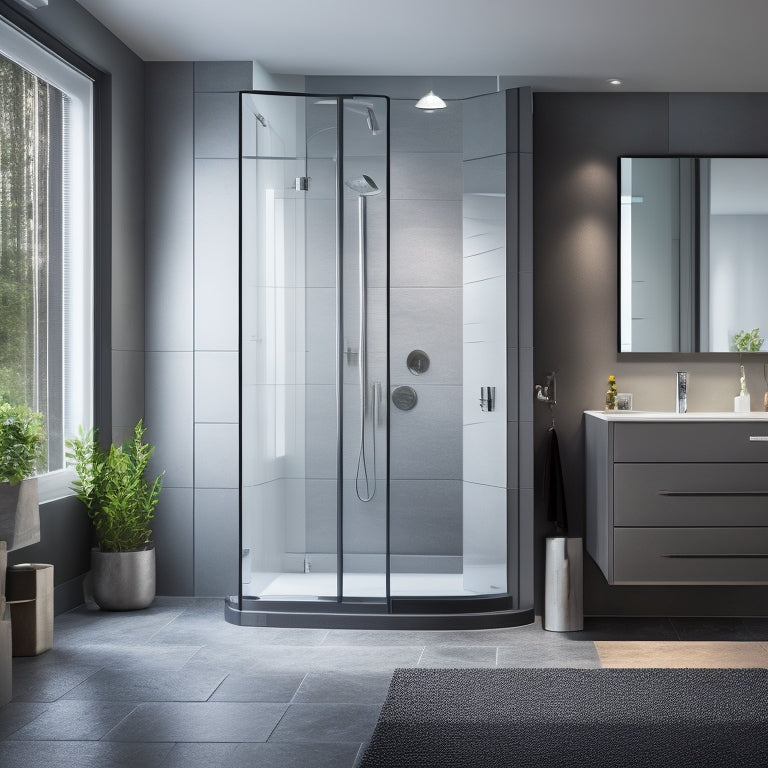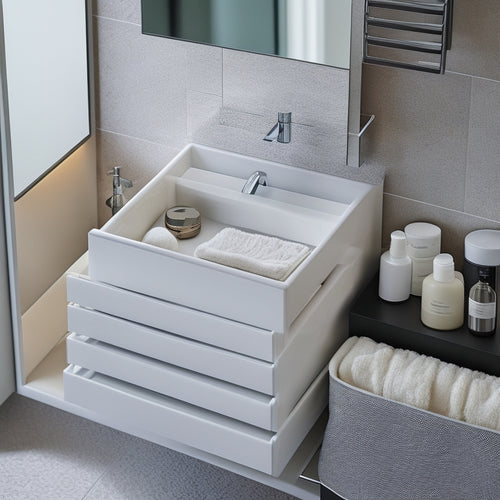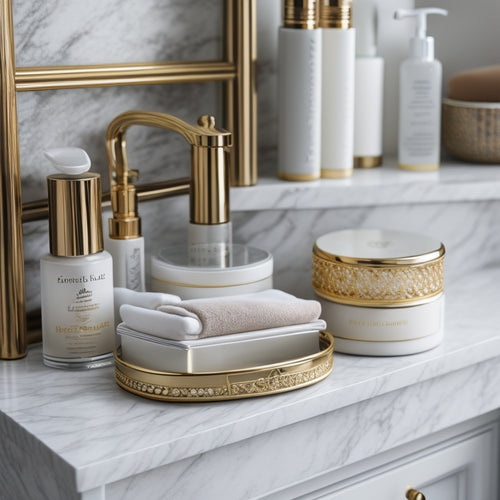
Durable Freestanding Bathroom Cabinets for Moisture Exposure
Share
When selecting a durable freestanding bathroom cabinet for moisture exposure, you'll want one that resists water damage easily, fights mold and mildew growth, and features a humidity-resistant coating inside. Look for materials like PVC, acrylic, and polyethylene, which are naturally resistant to moisture. Additionally, consider cabinets with corrosion-resistant aluminum frames and proper ventilation systems to maintain air circulation. Measure the cabinet depth carefully, ensuring at least 2-3 inches of clearance for door operation. By prioritizing these features, you'll find a cabinet that withstands humid conditions and remains functional and stylish - and exploring further will help you make an informed decision.
What You Need to Know
- Water resistance coatings, such as polyurethane-based and epoxy-based, create hydrophobic barriers to protect cabinets from moisture damage.
- Durable construction materials like PVC, acrylic, and stainless steel effectively resist water damage and corrosion in humid bathroom environments.
- Moisture-resistant materials, proper ventilation systems, and strategic design features prevent mold and mildew growth in bathroom cabinets.
- Accurate space planning and measurement ensure proper fit, functionality, and aesthetics in moisture-exposed bathroom cabinets.
- Clear storage bins, adjustable shelves, and corrosion-resistant hardware enhance functionality and durability in freestanding bathroom cabinets.
Resists Water Damage Easily
When you're shopping for a freestanding bathroom cabinet, you'll want to look for models with water resistance coatings that prevent moisture from seeping into the cabinet's interior.
Additionally, durable construction materials like solid wood or engineered wood with a water-repellent finish can help withstand exposure to humidity and water splashes.
Consider incorporating moisture-resistant materials to guarantee durability in humid environments.
Water Resistance Coatings
Two key factors contribute to the water resistance of freestanding bathroom cabinets: the material used for the cabinet's construction and the application of a water resistance coating.
When you choose a cabinet with a waterproof finish, you're guaranteeing that the surface is protected from moisture. This coating creates a hydrophobic barrier that prevents water from seeping into the cabinet's core.
To maximize storage and maintain a sense of openness in your bathroom, consider vertical space utilization and opt for wall-mounted cabinets that keep countertops clear and essentials accessible.
Moreover, incorporating adjustable shelves and hidden storage compartments can enhance both aesthetics and functionality.
You can additionally enhance the water resistance of your cabinet by following simple maintenance tips. Regularly clean the surface with a mild detergent to prevent dirt and grime from accumulating.
Avoid using abrasive cleaners or scrubbers, as they can scratch the finish and compromise its water resistance. Additionally, verify that the cabinet is properly sealed to prevent water from entering through gaps or joints.
Durable Construction Materials
Built with durability in mind, freestanding bathroom cabinets constructed from high-quality materials can effectively resist water damage. You want a cabinet that can withstand the humid environment of your bathroom, and that's where durable construction materials come in.
Look for cabinets made from sustainable materials like recycled wood, bamboo, or FSC-certified wood. These eco-friendly options not only reduce your carbon footprint but also guarantee your cabinet remains sturdy and resistant to water damage.
Additionally, incorporating clear storage bins and adjustable shelves can enhance the functionality of your cabinet and promote a clutter-free environment.
In addition to sustainable materials, consider the design aesthetics of your cabinet. A well-designed cabinet with a watertight seal can prevent water from seeping in and causing damage.
Look for cabinets with a sleek, modern design that incorporates features like raised floors, sloping tops, and adjustable shelves. These features not only enhance the visual appeal of your bathroom but also improve the functionality of your cabinet.
Fights Mold and Mildew
You'll appreciate that your freestanding bathroom cabinet is built with moisture-resistant materials that prevent water from seeping into the cabinet's core.
Additionally, ventilation systems are integrated into the design to guarantee air circulates freely, reducing humidity and the likelihood of mold and mildew growth.
Many modern aesthetics feature eco-friendly options that support sustainability without compromising style, which is especially important in high-moisture bathroom environments.
Moisture-Resistant Materials Used
By design, freestanding bathroom cabinets incorporate moisture-resistant materials to combat the humid environment they inhabit. You'll often find these materials used in combination to create a strong defense against moisture. For instance, a moisture barrier is typically applied to the exterior of the cabinet, preventing water from seeping in. This barrier can be made from materials like PVC, acrylic, or polyethylene, each with its own strengths and weaknesses.
Additionally, it's crucial to evaluate the style and material options to guarantee the cabinet blends with the overall bathroom aesthetic. Moreover, the cabinet's durability is also influenced by its ability to withstand cleaning products, which can be effectively stored in wall cabinets, enhancing organization and safety.
Regarding material comparisons, medium-density fiberboard (MDF) is a popular choice due to its affordability and resistance to warping. However, it can be prone to water damage if not properly sealed. In contrast, solid hardwoods like oak or maple are more durable but come at a higher cost.
Some manufacturers also use composite materials, which combine the benefits of different materials to create a highly resistant and long-lasting cabinet. When selecting a freestanding bathroom cabinet, look for materials that meet your needs and budget. By understanding the strengths and weaknesses of each material, you can choose a cabinet that will withstand the humid bathroom environment and provide years of reliable service.
Ventilation Systems Integrated
Regularly, freestanding bathroom cabinets are equipped with ventilation systems that play an essential role in fighting mold and mildew growth.
These ventilation systems are designed to provide ideal air circulation, guaranteeing that moisture-laden air is efficiently removed from the cabinet's interior. You'll appreciate the ventilation efficiency of these systems, which helps maintain a dry environment that's inhospitable to mold and mildew.
By implementing tiered storage systems and maximizing vertical storage, you can reduce moisture accumulation and create a more breathable space.
As you visualize the interior of your freestanding bathroom cabinet, imagine a constant flow of fresh air circulating through the shelves and compartments. This air circulation prevents the accumulation of stagnant air, which can lead to moisture buildup and subsequent mold growth.
The ventilation system's design guarantees that air enters and exits the cabinet through strategically placed vents, promoting a consistent exchange of air that keeps the interior dry and fresh.
Humidity-Resistant Coating Inside
When you choose a freestanding bathroom cabinet with a humidity-resistant coating inside, you're fundamentally applying a protective layer that shields the cabinet's interior from moisture.
You'll have options for a water-repellent finish, such as a nano-coating or a polyurethane-based treatment, to guarantee the cabinet remains dry and functional.
Protective Layer Application
You face a critical step in guaranteeing your freestanding bathroom cabinet remains functional and visually appealing: applying a protective layer inside. This humidity-resistant coating is essential to prevent moisture buildup and damage to the cabinet's internal components.
To achieve ideal results, focus on proper application techniques. Start by preparing the surface, verifying it's clean and dry. Next, apply the protective seals, carefully following the manufacturer's instructions.
Pay attention to the recommended thickness and coverage area to guarantee a uniform coating. Use a high-quality brush or roller to apply the coating, working in well-ventilated areas to prevent inhaling fumes.
Opt for application techniques that promote even distribution, such as working in small sections and using a consistent pattern. Avoid applying the coating in thick, heavy layers, as this can lead to uneven drying and reduced effectiveness.
Water-Repellent Finish Options
Two primary water-repellent finish options are available for the humidity-resistant coating inside your freestanding bathroom cabinet: polyurethane-based and epoxy-based coatings.
These waterproof finishes provide an additional layer of protection against moisture exposure, ensuring your cabinet remains durable and functional.
Polyurethane-based coatings offer a flexible, breathable finish that allows for minor expansions and contractions due to temperature changes. This flexibility makes them ideal for cabinets with movable parts, such as drawers or shelves.
Epoxy-based coatings, on the other hand, provide a rigid, chemical-resistant finish that's perfect for high-traffic areas or areas prone to heavy moisture exposure.
Both options provide excellent protective treatments against water damage and humidity. When applied correctly, they create a hydrophobic surface that repels water, reducing the risk of warping, cracking, or discoloration.
Measure Cabinet Depth Carefully
When selecting a freestanding bathroom cabinet, you'll need to measure the depth carefully to guarantee it fits comfortably in the available space.
A minimum clearance of 2-3 inches is typically required to allow for easy door opening and closing, so factor this into your calculations.
Accurate space planning is essential to avoid cramped quarters and make sure your cabinet doesn't obstruct other bathroom fixtures.
Minimum Clearance Requirements
At least 1 inch of clearance is required between the freestanding bathroom cabinet and the wall to confirm easy installation and maintenance.
This minimum spacing is vital to guarantee you can easily access the cabinet's back panel for plumbing and electrical connections. Failure to meet this requirement can lead to difficulties during installation, and even cause damage to the cabinet or surrounding walls.
When planning your bathroom layout, consider the installation guidelines for your specific cabinet model.
Check the manufacturer's instructions for recommended clearance measurements, as these may vary. You'll also want to account for any obstructions, such as plumbing fixtures or electrical outlets, that may affect the cabinet's placement.
Accurate Space Planning Needed
You'll need to measure the cabinet's depth carefully to secure accurate space planning in your bathroom. This is vital because a freestanding cabinet that's too deep can encroach on the floor space, making the room feel cramped and claustrophobic.
On the other hand, a cabinet that's too shallow mightn't provide sufficient storage, compromising your bathroom's functionality.
To guarantee ideal space utilization, consider the cabinet's design aesthetics and how they'll interact with your bathroom's layout. For instance, a cabinet with clean lines and a slim profile can create a sense of openness, while a bulkier design might visually shrink the space.
Measure the distance between the wall and any obstructions, such as plumbing fixtures or electrical outlets, to determine the maximum depth your cabinet can have. By doing so, you'll be able to choose a cabinet that not only fits your bathroom's unique dimensions but also enhances its overall functionality and visual appeal.
Aluminum Frames Resist Corrosion
You're likely familiar with the importance of corrosion resistance in bathroom cabinets, given the humid environment.
That's why you'll want to look for aluminum frames made from corrosion-resistant materials, such as anodized or powder-coated aluminum.
These materials guarantee the frame remains structurally sound and maintains its appearance over time, even when exposed to moisture.
Corrosion-Resistant Materials Used
When moisture accumulates in your bathroom, corrosion can quickly become a concern, causing your freestanding cabinet's structural integrity to deteriorate. To combat this, manufacturers use corrosion-resistant materials that can withstand the humid environment.
You'll often find stainless steel used in freestanding cabinets, as it's highly resistant to corrosion and can maintain its strength even when exposed to moisture. This material is particularly useful for the cabinet's frame, hinges, and other moving parts.
In addition to stainless steel, plastic composites are also used to resist corrosion. These materials are often used for the cabinet's shelves, drawers, and other components that don't require the strength of stainless steel.
Plastic composites are lightweight, easy to clean, and can withstand the humidity in your bathroom. By combining stainless steel and plastic composites, freestanding cabinets can maintain their structural integrity and functionality even in the most humid environments.
With these corrosion-resistant materials, you can have peace of mind knowing your cabinet will remain durable and functional for years to come.
Frequently Asked Questions
Can I Install Freestanding Cabinets on Uneven Bathroom Floors?
When installing freestanding cabinets on uneven bathroom floors, you'll face installation challenges, but don't worry, you can overcome them with leveling solutions like adjustable feet, shims, or self-leveling pads to guarantee a stable and secure setup.
Are Durable Bathroom Cabinets Suitable for Coastal Regions?
As you brave the tempests of coastal living, you'll need cabinets forged like ancient Viking ships - built with coastal materials that defy the salty air's corrosive grasp, boasting moisture resistance that'll keep your belongings dry and triumphant.
Do Freestanding Cabinets Come With Adjustable Shelves?
You'll find that many freestanding cabinets come with adjustable shelves, allowing you to customize shelf spacing to fit your needs. Check the weight capacity of each shelf to verify it can hold your heaviest items, securing your freedom to design your ideal bathroom layout.
Can I Customize the Color of Humidity-Resistant Coatings?
You can choose from a wide range of color options to match your bathroom's aesthetic, and rest assured that the humidity-resistant coating's effectiveness won't be compromised, as it's carefully engineered to provide maximum protection against moisture.
Are Freestanding Cabinets Compatible With Wall-Mounted Sinks?
As you steer through the vast ocean of bathroom design, you're anchored by the question of compatibility between freestanding cabinets and wall-mounted sinks. You'll find that, with careful planning, the cabinet's stability won't be swayed by the sink's height, ensuring a harmonious union.
Explore More
You've finally found the perfect durable freestanding bathroom cabinets that can withstand moisture exposure. By choosing cabinets with water-resistant materials, humidity-resistant coatings, and corrosion-proof aluminum frames, you're guaranteeing your bathroom stays mold- and mildew-free. Measure carefully to guarantee a snug fit, and consider the theory that a well-ventilated cabinet can reduce moisture buildup by up to 50%. With these cabinets, you can rest assured your bathroom will remain a safe and functional space.
Related Posts
-

Top-Rated Compact Shower Caddies for Small Showers
When searching for top-rated compact shower caddies for small showers, focus on space-saving designs that maximize ve...
-

Space-Optimized Drawer Systems for Bathrooms
Space-optimized drawer systems can totally revolutionize your bathroom's storage. By utilizing vertical space and inn...
-

Revamp Your Bathroom Drawers With Expert Tips
I'm ready to transform my bathroom drawers from cluttered chaos to serene sanctuaries. First, I'll empty and sort ite...


